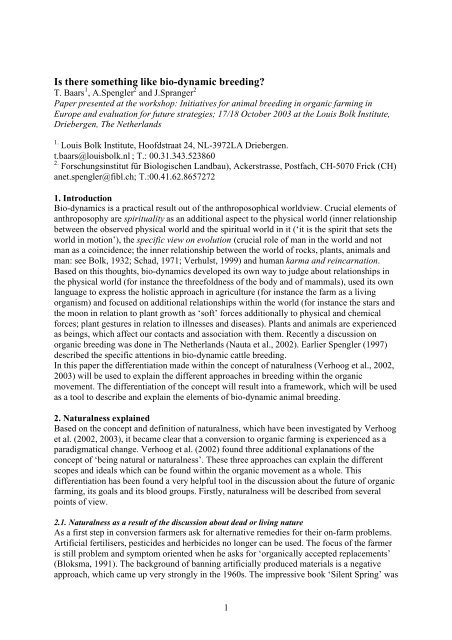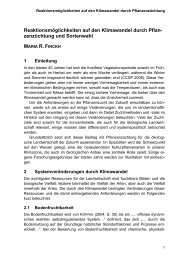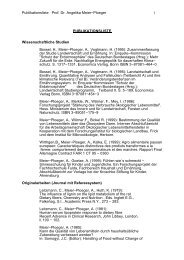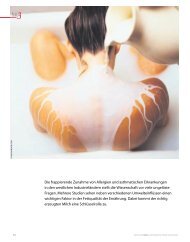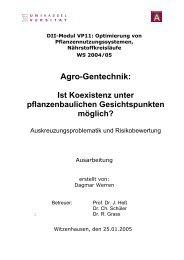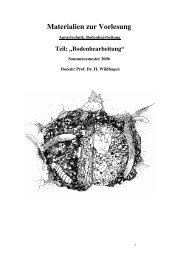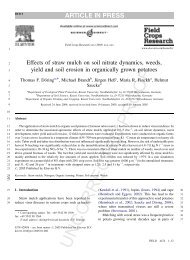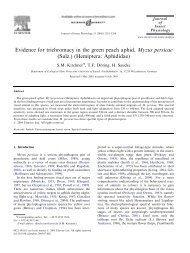Create successful ePaper yourself
Turn your PDF publications into a flip-book with our unique Google optimized e-Paper software.
Is there something like bio-dynamic <strong>breeding</strong>?<br />
T. Baars 1 , A.Spengler 2 and J.Spranger 2<br />
Paper presented at the workshop: Initiatives for animal <strong>breeding</strong> in organic farming in<br />
Europe and evaluation for future strategies; 17/18 October <strong>2003</strong> at the Louis Bolk Institute,<br />
Driebergen, The Netherlands<br />
1. Louis Bolk Institute, Hoofdstraat 24, NL-3972LA Driebergen.<br />
t.baars@louisbolk.nl ; T.: 00.31.343.523860<br />
2. Forschungsinstitut für Biologischen Landbau), Ackerstrasse, Postfach, CH-5070 Frick (CH)<br />
anet.spengler@fibl.ch; T.:00.41.62.8657272<br />
1. Introduction<br />
Bio-dynamics is a practical result out of the anthroposophical worldview. Crucial elements of<br />
anthroposophy are spirituality as an additional aspect to the physical world (inner relationship<br />
between the observed physical world and the spiritual world in it (‘it is the spirit that sets the<br />
world in motion’), the specific view on evolution (crucial role of man in the world and not<br />
man as a coincidence; the inner relationship between the world of rocks, plants, animals and<br />
man: see Bolk, 1932; Schad, 1971; Verhulst, 1999) and human karma and reincarnation.<br />
Based on this thoughts, bio-dynamics developed its own way to judge about relationships in<br />
the physical world (for instance the threefoldness of the body and of mammals), used its own<br />
language to express the holistic approach in agriculture (for instance the farm as a living<br />
organism) and focused on additional relationships within the world (for instance the stars and<br />
the moon in relation to plant growth as ‘soft’ forces additionally to physical and chemical<br />
forces; plant gestures in relation to illnesses and diseases). Plants and animals are experienced<br />
as beings, which affect our contacts and association with them. Recently a discussion on<br />
organic <strong>breeding</strong> was done in The Netherlands (Nauta et al., 2002). Earlier Spengler (1997)<br />
described the specific attentions in bio-dynamic cattle <strong>breeding</strong>.<br />
In this paper the differentiation made within the concept of naturalness (Verhoog et al., 2002,<br />
<strong>2003</strong>) will be used to explain the different approaches in <strong>breeding</strong> within the organic<br />
movement. The differentiation of the concept will result into a framework, which will be used<br />
as a tool to describe and explain the elements of bio-dynamic animal <strong>breeding</strong>.<br />
2. Naturalness explained<br />
Based on the concept and definition of naturalness, which have been investigated by Verhoog<br />
et al. (2002, <strong>2003</strong>), it became clear that a conversion to organic farming is experienced as a<br />
paradigmatical change. Verhoog et al. (2002) found three additional explanations of the<br />
concept of ‘being natural or naturalness’. These three approaches can explain the different<br />
scopes and ideals which can be found within the organic movement as a whole. This<br />
differentiation has been found a very helpful tool in the discussion about the future of organic<br />
farming, its goals and its blood groups. Firstly, naturalness will be described from several<br />
points of view.<br />
2.1. Naturalness as a result of the discussion about dead or living nature<br />
As a first step in conversion farmers ask for alternative remedies for their on-farm problems.<br />
Artificial fertilisers, pesticides and herbicides no longer can be used. The focus of the farmer<br />
is still problem and symptom oriented when he asks for ‘organically accepted replacements’<br />
(Bloksma, 1991). The background of banning artificially produced materials is a negative<br />
approach, which came up very strongly in the 1960s. The impressive book ‘Silent Spring’ was<br />
1
written by Rachel Carson (1963), who opened the world’s eyes on the long term effects of the<br />
highly persistent pesticides (aldrins, dieldrin, DDT, etc). However, earlier organic farmers<br />
were already negative about the effects of the first artificial fertilisers. Farmers found out that<br />
due to the introduction of fertilisers (since 1860) the fertility of their cattle was reducing and<br />
the maintenance of their own seeds became more difficult. This was the start of the<br />
biodynamic movement in the 1920s, when farmers asked Rudolf Steiner to explain to them<br />
his esoterical ideas about agriculture (Steiner, 1924). It were these negative experiences in the<br />
early 1920s which gave the basics for compost making and the focus on the development of a<br />
living soil (Balfour, 1946).<br />
Verhoog et al. (2002) mentioned this approach of organic farming in a negative way as ‘the<br />
no-chemical approach’. Behind it is the distinction between living (organic) nature and dead<br />
(inorganic) nature. The use of chemicals is associated with ‘dead’ nature and it is unhealthy.<br />
The orientation on this approach is very similar to that in conventional agriculture. This is the<br />
reference of the observer, including the way of thinking. Instead of chemical sprays against<br />
diseases, farmers use ‘natural’ sprays or biological controls, synthetic fertiliser has to be<br />
replaced by organic manure, and instead of herbicides mechanical weed control is used.<br />
In the growth of the organic sector in the 1990s this approach became more and more<br />
important. In 2001, Pollan described the development of the ‘Organic-Industrial Complex’,<br />
which is the rapid industrialisation and commercialisation of organic food production,<br />
especially in the USA. Pollan (2001) claimed that the way of thinking behind the<br />
industrialisation process is very conventional. The aim is to produce uniform organic products<br />
that have to be substantially processed to be able to transport them over long distances. The<br />
organic produce can be processed, except for the fact that natural additives are used instead of<br />
artificial flavours and substitutes. This leads traders and processors to alter the standards to<br />
allow all kinds of ‘natural additives’. To the consumer, organic farming is presented as a<br />
small, but healthy change. Organic produce is very similar to conventional produce, except<br />
for the fact that the (many) ingredients should not be artificial.<br />
Therefore the understanding of naturalness in this approach can be characterised as:<br />
• Replacements of artificial materials by natural materials (as an action)<br />
• Symptom oriented (as the way of thinking)<br />
• Fighting against nature<br />
• Materialistic world view (reductionistic view)<br />
2.2 Naturalness as a holistic systemic concept: agro-ecological laws<br />
As a second step in conversion to organic farming, Bloksma (1991) described the attention for<br />
the agro-ecological system. Problems or symptoms are no longer seen in isolation, and the<br />
focus is changing towards the context of the problem. Knowledge gathered in the 1960s and<br />
1970s among others by ecologists like Odum focus on the agro-ecosystem as a whole.<br />
Scientific thinking is now in terms of relationships, hard systems and energy flows. In<br />
agriculture, the farm as an agro-ecological system was formulated as a new level of analysis<br />
and as a context of detailed research questions. Instead of the farm’s components, the total<br />
farming system became the focus of attention (See also Alrøe and Kristensen, 2002).<br />
Verhoog et al. (2002) mentioned this attention for organic farming as ‘the agro-ecosystem<br />
approach’. The farmer learns from nature and reflects on processes in nature. In practice this<br />
means that the organic farmer wants to model his agricultural practice on nature like an agroecosystem.<br />
Farmers might experience that during their conversion period they cannot ignore<br />
the ecological context of emerging problems. They notice that under organic circumstances it<br />
is not sufficient to only stop using chemical pesticides and artificial fertilisers. A new attitude<br />
2
and another way of acting is needed, based on prevention through knowledge of ecological<br />
processes. Diseases are seen as symptoms of an unbalanced system expressed in the lack of<br />
balance between plant or animal and farm environment. Rather than fighting pests and<br />
diseases with chemicals, the emphasis shifts to control of the environment. A more diverse<br />
environment is necessary in which wild plants in hedges, borders or ditches are grown to<br />
maintain natural enemies within the farm system. Plant strength can also be increased through<br />
the right choice of manure, or by sound crop rotation. All this means that farmers start to<br />
think in a more ecological way, looking for the broader context of a problem and realising<br />
that the farm should be transformed into a complex, sustainable and balanced agro-ecosystem.<br />
Terms such as closed system, mineral cycle, self-regulation and bio-diversity are important<br />
keywords to characterise naturalness in this approach of organic agriculture. One needs to<br />
work together with nature instead of fighting against it. Solutions are based on rational,<br />
experiential and experimental ecological knowledge. Therefore the understanding of<br />
naturalness in this approach can be characterised as:<br />
• Focus on balancing the agro-ecological system based on preventive management (as an<br />
action)<br />
• Context-oriented, based on relationship knowledge in auto-ecology and syn-ecology (as<br />
the way of thinking)<br />
• Co-operating with nature<br />
• Systemic world view (as a complex hard system and its inner processes)<br />
2.3 Naturalness as a holistic meeting of the other being: entity or integrity<br />
However, Bloksma (1991) found a third approach to orient on problems in organic farming<br />
systems. The attitude is not only based on the knowledge of the agro-ecological context, but<br />
also on the inner meaning of the problem or the observed itself and the personal relationship<br />
of the farmer to the object. At first, this orientation was recognised in the field of man and<br />
animal, when the topic of integrity and entity was introduced. However, recently Lammerts<br />
van Buren (2002) introduced a view on the integrity of plants as well, when she discussed the<br />
<strong>breeding</strong> goals in organic farming.<br />
In the discussion on animal welfare a new and additional point of view was introduced which<br />
was not covered by measurable health and welfare parameters (Grommers, 1995; Visser and<br />
Verhoog, 1999; Verhoog, 2000). For instance, the mutilation of farm animals, the goals of<br />
animal <strong>breeding</strong> were not covered by the existing welfare definitions and additionally the<br />
animal was seen as ‘a being on its own’. In organic farming this way of thinking is found in<br />
terms as ‘the farm as an organism alike’ and ‘the living soil organism’. This additional<br />
element in the welfare discussion was covered by the concept of ‘animal integrity’.<br />
As said, this respect for the animal’s integrity first emerged in animal husbandry and was<br />
transformed into the concept of ‘the animal’s needs’ (Rist, 1987; Bartussek, 1991). Cattle<br />
should be fed as ruminants instead of monogastrics (Bakels and Postler, 1986; Haiger, 1989;<br />
Spengler, 1997). They should be kept as horned animals in a well-balanced herd. De-horning<br />
can only be avoided if the farmers are prepared to develop a new way of herd management,<br />
housing and feeding based on the cow’s needs (Baars and Brands, 2000; Waiblinger et al.,<br />
2000). Also the cows’ right for outdoor grazing is derived from respect for the cow’s ‘nature’.<br />
Outdoor grazing can not be replaced by an outdoor run only. This approach manifests itself<br />
among others as respect for the integrity of life, for the agro-ecosystem, and for human needs<br />
(including social and economic integrity). The term ‘natural’ here refers to taking into account<br />
the characteristic nature of plants, animals, man and ecosystem because nature has an<br />
intrinsic value. Respect for the integrity of the farm ecological system, the living soil, the<br />
3
plant and animal species used is the result of an inner process of involvement with the way of<br />
being of natural entities. Farmers begin to experience that their focus on problems and<br />
solutions is connected with their personal attitude and their personal relationship with either<br />
the soil or the cultivated plants or animals. They experience that organic farming is more than<br />
a complex ecological mechanism and more than the sum of the parts. This feeling is also<br />
present in relation to the plants or animals they take care of. They develop a respect for the<br />
wholeness, harmony or identity of a living entity based on a personal involvement with the<br />
life of plants or animals.<br />
Verhoog et al. (2002) mentioned this approach of organic farming ‘the integrity approach’.<br />
The recognition of integrity reflects an attitude of respect that inspires the farmer to find the<br />
right course of action at the right moment in the specific farm context. Therefore the<br />
understanding of naturalness in this approach can be characterised as:<br />
• Action is based on the respect for the identity of the observed itself (soil, plant, animal and<br />
the farming system) (as an attitude before action)<br />
• Entity-oriented, based on a personal identification of the farmer (as the way of thinking)<br />
• Working together based on an inner understanding of the other’s nature<br />
• Holistic world view, based on the connection with the observed.<br />
These three approaches are a very helpful tool to distinguish in several discussions of organic<br />
farming, for instance ‘how to think about GMO’s in organic farming’ (Baars, 2002) or ‘what<br />
is the identity of the economical process in relation to regionality and Fair Trade’.<br />
2.4. Naturalness in relation to aspects and choices in organic <strong>breeding</strong><br />
In Table 1 the application of the general scope on naturalness is made for animal <strong>breeding</strong>. In<br />
the first column the general focus explained above is repeated. Column 2 explains the<br />
characteristics of each approach in terms of a view on <strong>breeding</strong>, whereas the third column has<br />
been used for examples of the specific focus.<br />
Table 1. Elements of naturalness adapted for approaches within organic animal <strong>breeding</strong><br />
Approach of Essential conditions, points of departure and This will lead to …<br />
naturalness attitude);<br />
(Practical examples)<br />
No chemical 1. Breeding is the genetic improvement of animals 1. Efficient and high productive<br />
approach: (by cross<strong>breeding</strong> and selection) focused on DNA to sires and dams without<br />
With regard to have an efficient use of substances (The animal is embryotransfer in their pedigree;<br />
animal <strong>breeding</strong> equal to its DNA; the animal as a produce). The In vitro fertilisation and ovum<br />
the main focus is environment is seen as the second, the follower, pick up are not allowed<br />
the genome. Life is which will be standardised world wide.<br />
2. Hybrid crosses for all species<br />
only physical and 2.With the help of quantitative calculations the best 3. No GMO, because of the use<br />
the animal is only a animals will be selected out of a world population. of artificial materials<br />
production factor Breeds are not important.<br />
4. Artificial Insemination is<br />
for the system. 3. Breeding knowledge is based on quantitative allowed for pragmatic reasons.<br />
Thinking about the genetics.<br />
5. Interventions at a chemical<br />
world in terms of<br />
level in the fertility cycle are not<br />
parts which can be<br />
constructed<br />
allowed (f.i. hormones, ET).<br />
Agro-ecological 1. Breeding is based on the knowledge of animal 1. Line<strong>breeding</strong> and threecross<br />
approach: ecology and physiology and oriented on balancing of rotations based on longevity<br />
The context of the functions related to secondary production<br />
2. Index for longevity or<br />
genome (= the characteristics:<br />
sustainability in a conventional<br />
animal as an - type of animal (built, shape, longevity),<br />
<strong>breeding</strong> program (OGZ)<br />
4
individual being)<br />
and the context of<br />
the animal (= the<br />
herd and the<br />
farming system)<br />
are the central<br />
focus:<br />
- ecological<br />
coherence<br />
- thinking in<br />
processes<br />
- support of selfregulation<br />
- system oriented<br />
Integrity<br />
approach:<br />
The animal’s<br />
integrity is the<br />
main focus:<br />
- life has its own<br />
specific<br />
dimensions;<br />
- respecting the<br />
integrity (entity)<br />
- explicit role of the<br />
human being<br />
- man and nature<br />
create something<br />
additional<br />
- oriented on the<br />
identity<br />
- animal and environment.<br />
2. Breeding is focused on the selection of animals<br />
that fit in a regional, land related farming situation.<br />
3. As a result of <strong>breeding</strong> the individual animal<br />
should be in balance.<br />
4. Breeding is based on quantitative animal models,<br />
which include additional values for an efficient<br />
animal production.<br />
1. Breeding is the eliciting of animal characteristics<br />
with the respect for and the insight into the species,<br />
the breed and the individual animal:<br />
- insight in the animal type<br />
- insight in the role of the animal into the system as a<br />
whole.<br />
Through this focus the specific value on its own of<br />
each breed will be strengthened in a specific cultural<br />
environment.<br />
2. Breeding is based on the personal insights of the<br />
breeder about the animal needs and the environment<br />
he provides them, and the adaptation to the farm<br />
circumstances.<br />
3. Genes are seen as the inner preconditions for the<br />
development of organisms; not the genes are creating<br />
features, but the animal species do so according to<br />
the inner preconditions of the genes and the outer<br />
preconditions of the environment. Cytoplasmatic<br />
hereditary has to be taken in account.<br />
4. The limits of <strong>breeding</strong> and the <strong>breeding</strong> goals are<br />
affected by the consciousness of the animal’s<br />
integrity.<br />
5. Optimising environment for an animal species is a<br />
way of <strong>breeding</strong>: it opens the possibility for the<br />
animal species to show it’s whole integrity in the<br />
single organism.<br />
5<br />
3. Harmony of built and shape:<br />
for instance Weeks’ Triple aAasystem;<br />
Selinger and Dekker:<br />
the golden section as a harmony<br />
imagination.<br />
4. Refusal of GMO, because of<br />
side effects for the animal itself<br />
(health, welfare) and the<br />
environment<br />
5. Searching for suitable,<br />
regional breeds for specific<br />
styles of organic farming<br />
(importance of genotype x<br />
environment interaction)<br />
1. Dutch Frisian breeders: kin<br />
<strong>breeding</strong> and on-farm<br />
development of lines.<br />
2. Specific meaning of the<br />
species within the mammal<br />
kingdom (Schad) in relation to<br />
its specific characteristics<br />
(Spengler)<br />
3. Ideal imagination of the cow:<br />
f.i. the cow with a highly<br />
specialised digestion- and<br />
metabolic system to transform<br />
roughage and highly<br />
differentiated limbs: a walking<br />
animal and sex dimorphism<br />
(Bakels)<br />
4. A personal and inner<br />
imagination of the animal:<br />
Endendijk’s imagination of the<br />
ideal cow.<br />
5. Refusal of GMO because the<br />
natural mating is taken from the<br />
animal; the technique is forcing<br />
the matter and crosses natural<br />
boarders of species.<br />
6. The natural way of mating<br />
cannot be taken from the animal.<br />
3. The elements of bio-dynamic animal <strong>breeding</strong><br />
Ideas about bio-dynamic <strong>breeding</strong> have been explicitly formulated by Spengler (1997) and<br />
can be derived from Baars and Nauta (2001; 2002). As a more general statement about<br />
organic animal <strong>breeding</strong>, Baars and Nauta (2001; 2002) formulated that <strong>breeding</strong> in organic<br />
farming should enlarge the race diversity, focus on the herd adaptation and respect the<br />
harmony of the animal build. Spengler (1997) stresses the relationship of the genome in<br />
relation to the (spiritual) being and the role of the environment.
Below these elements are further explained taking into account that these aspects can be<br />
recognised as different views on naturalness (compare Table 1).<br />
3.1. The role of the genome in relation to the environment (Spengler, 1997)<br />
Spengler introduced two important elements of the bio-dynamic <strong>breeding</strong> view as an<br />
expression of the integrity approach:<br />
(1) Not the genes are creating the organisms nor they are the features of the organisms.<br />
However, there is a principal entity ruling the whole organism including its genes; like<br />
any principal this is not a material thing, but a spiritual or mental activity. It can be seen as<br />
the “intrinsic mental activity of the animal species” (Rist et al., (1996) and (Rist et al.<br />
(2000)) or “morphogenetic fields” (Sheldrake, 1983) or “the mind of the group (species)”<br />
(Steiner, 1912, (1923)) or the “typus” as the principal organism (Goethe (1795); Steiner<br />
(1886)). The genes are seen as the inner physical preconditions for the species to develop<br />
the organisms (compare the piano in relation to the composer and his score).<br />
(2) The preconditions of the environment are important for the development of organisms as<br />
well (genotype x environment-interactions!): the more they fit to the species-specific<br />
characteristics the better the species can show its intrinsic features in the single organism<br />
(compare 3.4). To characterise these species-specific characteristics, Spengler used the<br />
investigations of Schad (1971): f.i. the cow as an ungulate with highly specialised limbs<br />
and as a ruminant with a very highly specialised digestion- and metabolic system. The<br />
preconditions of the environment are to a great extend influenced by humans. Referring to<br />
Steiner’s “Agricultural course” (Steiner, 1924) it is even thought that the environmental<br />
conditions are taken up in the heredity of the breed. (Actually this kind of thinking is<br />
connected to Lysenko <strong>breeding</strong> and part of the nature-nurture discussion.) Spengler<br />
mentioned the word ‘preconditional <strong>breeding</strong>’, which doesn’t mean that just the<br />
preconditions are <strong>breeding</strong> the animals, but that they play a great role for what kinds of<br />
breeds the species themselves can create. The preconditions of the environment and the<br />
preconditins of the genes as well are seen as the “boundaries” for the species creating<br />
individual organisms. That’s why in such a <strong>breeding</strong> the herdsman should be ‘in<br />
conversation with his animals to elicit the proper phenotype’.<br />
3.2. Genetic diversity by site adapted landraces (Baars and Nauta, 2001, 2002)<br />
As an expression of the agro-ecological approach, bio-dynamic <strong>breeding</strong> should be used to<br />
reinforce the relationship between the animal breed and the environment in which it has to<br />
live. Plants and animals express themselves differently in different environments. Differences<br />
between farms spring from differences in soil quality, their situation in climatic zones, etc.<br />
(compare Spengler’s ‘preconditional <strong>breeding</strong>’). Therefore, out of this view <strong>breeding</strong> and<br />
improvement should follow on from the improvement of the original native breeds. That is to<br />
say, one aims for small-scale improvements that consciously seek to reinforce those qualities<br />
that suit a particular environment. It is not so much a question of adapting as of fitting in.<br />
The family <strong>breeding</strong> method as currently practised by a handful of individual breeders ensures<br />
that a farm-specific cow will emerge within a current farm environment (Baars, 1990). Family<br />
<strong>breeding</strong> offers ideal opportunities to achieve versatility. Regionally oriented <strong>breeding</strong> of this<br />
nature makes it possible to reflect the diversity present in the different landscapes in<br />
physiology and behaviour of a domesticated animal such as the old landraces. Animals and<br />
surroundings can thus be brought into balance and be further improved together.<br />
6
3.3. A sense of beauty and proportion: harmony in build (Baars and Nauta, 2001; 2002)<br />
As an expression of the agro-ecological approach, some breeders also consciously take<br />
account of the ‘harmonious proportions’ of the animal in addition to biased production<br />
characteristics. An animal’s build and bone structure are considered important determinants of<br />
whether an animal will be a good milking cow. The American Bill Weeks developed the<br />
‘aAa’ (triple A) system, in which he supplements production-based criteria with the strong<br />
and weak points of an animal’s build. In pairing a dam and a sire he tries to select animals in<br />
such a way that their offspring will be a more harmoniously built dairy cow. Weeks posed<br />
that the better a farm succeeded in ‘harmonious’ pairings, the longer the mean life expectancy<br />
of the herd, in comparison with farms that did not practice compensation pairing. The ideal<br />
cow averages out all the extreme types in its build and stands at the centre of a circle (Figure<br />
1). The extreme types make up the circumference of the circle.<br />
Figure 1. Sketch of an aAa pairing: extreme builds of animals are categorised in six main<br />
types. Each cow receives a visual score for the three strong and the three weak points in her<br />
build. In the mating the weak points in build are compensated by the selection of a bull with<br />
as many compensating characteristics as possible.<br />
Another view of the harmony concept can be traced back to Dutch Friesian breeder, Dirk<br />
Endendijk (Baars, 1990). As a breeder he values a harmoniously built cow. Harmony in build<br />
makes a milk cow into a good <strong>breeding</strong> cow. Endendijk judges this by eye from his own sense<br />
of harmonious proportions. Such a personal relationship can be seen as an expression of the<br />
integrity approach. Parallel, in the 1970s, the Dutch Friesian breeder Cees Dekker defined<br />
‘the ideal Dutch Friesian cow’. Dekker goes so far as to indicate the ideal cow in numerical<br />
proportions of all body elements. What is striking about Dekker’s definition is that it<br />
7
essentially comes down to the numeric ratios of 1:2 and sometimes 1:3 1 . The type of focus on<br />
ratios by Dekker shows much similarity to the ratio in the Divine Proportion 2 that was used<br />
in the design of paintings and buildings and that led to a harmonious composition. It should<br />
be noted that Endendijk, Dekker and Weeks are all concerned with the relationships between<br />
body measurements, and not with the absolute value of the different variables. This concern is<br />
a typical expression of an agro-ecological approach at the level of the individual animal.<br />
Consciously or unconsciously, all three breeders have an instinctive sense of beauty that is<br />
normally only discussed within arts instead of science.<br />
Another way of incorporating a feeling for interrelationships and proportions is to consciously<br />
consider the effect that, say, <strong>breeding</strong> for milk production may have on the rest of the animal.<br />
Genetic progress (in terms of milk production) appears to proceed fastest when <strong>breeding</strong> goals<br />
focus on only one or a few characteristics. However, in that case one must also consider the<br />
characteristics that are changed unintentionally and simultaneously. Conventional breeders as<br />
Endendijk, Dekker and Weeks looked at the interrelationships between the different<br />
characteristics. In this way they can prevent <strong>breeding</strong> focusing too singularly for a specific<br />
characteristic such as height or INET 3 (Hansen et al., 1999). The danger in reducing <strong>breeding</strong><br />
to milk yield is that the context in which the data were collected can no longer be assessed.<br />
Increased milk yield may lead to fertility problems (Ostergaard et al., 1990) and reduced<br />
efficiency of fodder utilisation (Yerex et al., 1988), mainly because of reduced attention to<br />
cow height and cow weight. For this reason it is essential to test data continuously in real life,<br />
looking at the animal as a whole (Endendijk, 2000). This also prevents certain characteristics,<br />
such as fertility and life expectancy, to be forgotten or overlooked. Again, this is an<br />
expression out of an agro-ecological approach at the level of the individual cow.<br />
3.4. Action-based on animal’s integrity: animal-specific criteria (Baars and Nauta, 2001, 2002)<br />
Another alternative to prevent reducing the cow to its component parts was formulated by<br />
Professor F. Bakels (Haiger et al., 1988; Haiger, 1989; Postler, 1990). As a geneticist and<br />
veterinarian, Bakels developed a <strong>breeding</strong> programme that centers on ‘lifetime production’,<br />
which can be seen as an agro-ecological criterion. Bakels’ basic premise is to carry out<br />
selection based on characteristics that include all the sub-aspects of the cow (this method can<br />
also be applied to pigs and poultry). Here we are concerned with finding criteria which are not<br />
inspired by economic considerations (for example protein and fat content and now<br />
lactoglobulin content) but which are taken from the totality of the cow as a living organism.<br />
Bakels formulated the agro-ecological balance of the individual animal in a positive way,<br />
when he introduced the primary selection characteristic as vitality (or fitness), the capacity of<br />
an animal to remain productive throughout its life without any serious problems. This is<br />
translated into life expectancy and energy production during life (in offspring and/or milk and<br />
meat) (Zeddies, 1972; Essl, 1989; Postler, 1990).<br />
To assess Bakels’ viewpoint properly, it is important to understand that he attaches value to,<br />
among other things, the process of domestication of the cow and the regular behavioural<br />
patterns which the animal itself displays in this process. In this sense, Bakels, unlike Weeks,<br />
1 Dekker developed standard measures for the Dutch Friesian defined on an age of 4-5 years. In total he used 33<br />
points for his score of an ideal body build (see Baars, 1993). As an example the proportions from the udder: the<br />
udder length should be 45 cm; udder depth measured from the belly 22.5 cm; distance between the teets 11.5 cm<br />
and teet length 5.5-6 cm.<br />
2 The divine proportion or golden section ratio is 1:1.6180 (Huntley, 1970)<br />
3 The Dutch calculation of improved milk yield through <strong>breeding</strong> expressed as additional income.<br />
8
Endendijk and Dekker, has an additional consideration for the intrinsic characteristics of the<br />
cow as a criterion of integrity. He allows the animal itself, as it were, to indicate the limits<br />
which should be observed in <strong>breeding</strong> in order to evaluate the cow as a cow. Bakels shows in<br />
his ‘nature-like <strong>breeding</strong> method’ how the domestication process has proceeded from<br />
prehistoric cattle to our domesticated cow. From this domestication process he traces all kinds<br />
of functional characteristics which are now a proper part of the cow. The following<br />
characteristics should be considered in the <strong>breeding</strong> process of dairy cows (Postler, 1990;<br />
1991):<br />
• sexual dimorphism: bulls should be male-like in their expression and body figures and kept<br />
for meat production, whereas cows should be feminine and kept for milk production<br />
• cows are long distance walkers<br />
• cows are ruminants (compare Schad, 1971 and Spengler, 1997)<br />
• cows have a functional build (pelvic shape, flexible back)<br />
• physiological traits which are sex-linked.<br />
With this system Bakels developed practical and practicable <strong>breeding</strong> and selection<br />
characteristics which leave the domesticated animal as ‘whole’ as possible, and which are in<br />
keeping with the ‘nature’ and behavioural preferences of the animal (Haiger et al., 1988;<br />
Haiger, 1991).<br />
Schad (1971) focuses on animal <strong>breeding</strong> out of an integrity approach, when he chooses<br />
another entry point to identify the typical characteristics of the ‘cow being’. Based on the<br />
morphology and build of the animal species, its behavioural traits, and vital functions Schad<br />
classifies mammals into three main groups: rodents, predators and ungulates (compare<br />
Spengler in 3.1). Schad states that this trinity is a reflection of the threefold structure of man’s<br />
spirit: thinking, feeling and willing (see also Table 2.1). Baars E. and Nierop (in prep.)<br />
prepared a statistical analysis of these morphological principles. They showed, that the basics<br />
of these three main mammal groups were found in e.g. morphology, growth rate, teeth and<br />
birth. All the different types of animals show a certain bias. By becoming aware of these<br />
biases, we can ask ourselves what function each animal will serve for nature, agriculture and<br />
man. According to these correlations, Schad’s work illustrated that a cow, for instance, is in<br />
the first instance the perfect example of a roughage converter because of her special anatomy<br />
and physiology. The animal metabolises and transforms plant substances into milk, meat and<br />
manure, heat, work etc.<br />
Such an elaboration makes one aware of the typical characteristics of, say, cows. Just as<br />
Bakels’ approach, Schad’s can clarify what kind of being we are dealing with. Human action<br />
could now be aimed at housing and feeding all domesticated animals in accordance with their<br />
nature. Breeding and selection must allow the essential characteristics of each domesticated<br />
animal to come into their own. Bartussek (1991) indicated gradations of ‘naturalness’ in the<br />
agricultural production system. For this purpose he designed an ‘animal need index’ for<br />
feeding, welfare and <strong>breeding</strong>. Criteria for the index are drawn from animal-specific needs<br />
and can be seen as an expression of the integrity approach. Rist (1987) also started from the<br />
level of animal-specific needs with regard to animal welfare and housing. Rist pointed out<br />
that the psyche and its expressions, both in terms of well being and suffering, are examples of<br />
immanent forces. Herein lies the problem with the positivistic scientist, whose numerically<br />
based approach overlooks this immaterial level (see also Rist et al., 2000).<br />
9
3.5. Three-foldness as a <strong>breeding</strong> system?(Baars and Nauta, 2001, 2002)<br />
It is striking how often <strong>breeding</strong> systems are based on 3 lines or families. In pig <strong>breeding</strong>, for<br />
example, often a three-way cross is used of three inbred non-related lines with complementary<br />
practical characteristics. The offspring of this cross are the most highly-productive animals in<br />
practice. Bakels too opted for three lines when choosing his parent material. Further study of<br />
these lines (Haiger et al., 1988) makes it clear that they complement each other on many<br />
points (early maturing, late maturing, conformation, long-leggedness, milk production, fat and<br />
protein contents). Dirk Endendijk also uses three main lines on his farm, (Kate, Sjoukje and<br />
Jantje) plus a few other complementary families. In Weeks’ aAa system we also see a division<br />
of the two main types into three subtypes. Qualities can be found in these subtypes which can<br />
in part be traced back to the three-part system developed by Schad (1971).<br />
It may be that this three-part system is not a coincidence but the elaboration of a natural law,<br />
connected to the three qualities of man, as elaborated previously by Schad. It is clear from the<br />
above examples that a more balanced, more harmonious entity is created by bringing together<br />
and harmonising three different qualities. By consciously striving to harmonise these different<br />
qualities for every animal species or breed, a more balanced animal will result. Breeders could<br />
become more aware of the different qualities and biases in individual animals. Good,<br />
balanced, practical animals occur when the types are brought together by pairing. Bakels, for<br />
example, advises farmers to apply rotational cross<strong>breeding</strong> in which lines A, B and C<br />
continually succeed each other. Further research and further elaboration of this idea with a<br />
group of cattle experts would be worthwhile. In so doing it will be important to properly<br />
explore the three qualities and assess them on their own merits.<br />
4. The practice of biodynamic <strong>breeding</strong><br />
4.1. Biodynamic Cattle Breeding in Switzerland<br />
In Switzerland there are around 200 biodynamic (Demeter-) farms. Around 110 of them are<br />
keeping dairy cattle. The Swiss “Braunvieh” and the “Simmental x RH” are the most frequent<br />
races on biodynamic farms. Some breeders are practicing kin <strong>breeding</strong> with the “Original<br />
Braunvieh (OB)”-race or with the “Simmental”-race. There is no dehorning of animals on<br />
biodynamic farms. The average milk yield over all biodynamic farms in Switzerland amounts<br />
to about 5’500 – 6’000 l per cow and year.<br />
Around 40 biodynamic farmers are specially interested in dairy cattle <strong>breeding</strong>. Most of them<br />
are keeping their own sires and their family <strong>breeding</strong> is based on their personal insights about<br />
the animal needs and the enviroment they provide them (“preconditional <strong>breeding</strong>”). All of<br />
them are passive or active members of the swiss “work group for biodynamic cattle<br />
<strong>breeding</strong>”: around 15 biodynamic breeders are meeting 2 or 3 times a year on one of their<br />
farms to discuss special <strong>breeding</strong>-questions, -problems or -ideas arising on this farm and to<br />
improve their understanding of the animal. The human-animal-relationship, the use of<br />
technical aid and installations in the barn and in the milking parlour and the dimensions and<br />
structures of loose housing systems are important subjects disussed in this work group. The<br />
exchange of animals among biodynamic breeders is organised by a monthly published list of<br />
animals for sale and of wanted animals.<br />
4.2. Biodynamic Cattle Breeding in The Netherlands<br />
In 2000 an inquiry was made on <strong>breeding</strong> purposes of organic farms (Elbers and Nauta,<br />
2000). Actual farm figures of the year 2000 were related to the year of conversion and the<br />
blood group of the farmer (EKO versus biodynamic). There was a response of 155 farms,<br />
10
only 17% out of these were biodynamic farmers. Some general tendencies are found within<br />
the total group of organic (EKO + biodynamic) dairy farmers, shown in the left side of the<br />
table. There is a steady increase of milk yield per cow. The percentage of dairy type within<br />
the herds increased, whereas the use of ‘new’ dual purpose breeds decreased. At the same<br />
time the use of artificial insemination for mature animals increased till 90% of the<br />
fertilisations, whereas young stock was artificially fertilised for 84%. The percentage of onfarm<br />
bulls used for natural mating decreased until only 30%.<br />
At the right side of the table some typical characteristics of the biodynamic farms are shown:<br />
in comparison to the EKO farms, biodynamic dairy farmers produced less milk per cow (-<br />
1112 kg), had smaller farms in terms of milk quota (- 104,000 kg) based on less cows per<br />
farm (12.0 cows). The type of cow at the biodynamic farms was less based on pure bred dairy<br />
type (- 19%), whereas more breeds of a ‘new’ dual purpose origin were used (+ 24%).<br />
Biodynamic farmers used less artificial insemination, both on mature animals (- 18%) and<br />
young stock (- 30%) and the number of fertilisation by natural bulls were higher (+ 29%).<br />
Biodynamic farms were much older, the year of conversion was much earlier (- 9 years) than<br />
the EKO farms and there was hardly any conversion to biodynamics after 1997. Although<br />
these results are interconnected (being older and being biodynamic), it shows that biodynamic<br />
farms do have a different approach on animal <strong>breeding</strong>, which fit with the overall description<br />
shown in this paper.<br />
Year of conversion<br />
Characteristic<br />
like natural mating. However, such actions cannot be only attributed to bio-dynamics,<br />
although such practice fits very well in the bio-dynamic ideas (for instance ‘family <strong>breeding</strong>’).<br />
Out of the right gut feeling of practitioners and several scientists and without the specific<br />
anthroposophical backgrounds very similar values in <strong>breeding</strong> were found (for instance<br />
Bakels’ view on the cow as a being or Dekker’s inner feeling for harmonious cows).<br />
Additional points of view in bio-dynamic <strong>breeding</strong> which are a contrast to the conventional<br />
<strong>breeding</strong> views are: the role of the genome in relation to the environment on the one hand and<br />
the being in relation to the intrinsic mental activity of the species on the other hand.<br />
6. References<br />
Alrøe H.F., and Kristensen E.S. (2002) Towards a systemic research methodology in agriculture.<br />
Rethinking the role of values in science. Agriculture and Human Values, 19 (1): 3-23<br />
Baars E. and Nierop D. (in prep) Toetsing en voorspelling van het driegeledingsprincipe bij<br />
zoogdieren op basis van lichamelijke kenmerken. Louis Bolk Institute, Driebergen, The<br />
Netherlands.<br />
Baars T. (1990) Dirk Endendijk – 21 jaar familiteelt 1967-1988. Louis Bolk Institute, Driebergen, The<br />
Netherlands<br />
Baars T. (1993) Een visie op fokkerij in het licht van genetische manipulatie. Louis Bolk Institute, 60<br />
pages.<br />
Baars T. (2002) Naturalness and <strong>breeding</strong> in organic farming. In: D.Heaf and J. Wirz (eds) Genetic<br />
Engeneering and the Intrinsic Value and Integrity of Animals and Plants. Workshop in Edinburgh,<br />
UK, 18-21 September, Ifgene, 58-61<br />
Baars T. and Brands L. (2000). Een koppel koeien is nog geen kudde. Louis Bolk Instituut,<br />
Driebergen, NL. 67 pages.<br />
Baars T. and Nauta W. (2001) Breeding for race diversity, herd adaptation and harmony of animal<br />
build: a <strong>breeding</strong> concept in organic farming. In: Hovi M. and Baars T. (eds) Breeding and feeding<br />
for health and welfare in organic farming. 4 th NAHWOA Workshop, Wageningen, The<br />
Netherlands, 107-113.<br />
Baars T. and Nauta W. (2002) Vision formulation: <strong>breeding</strong> for local genetic diversity, herd adaptation<br />
and harmony. In: Baars T. (2002) Reconciling scientific approaches for organic farming research;<br />
Volume I: Reflection on research methods in organic grassland and animal production at the Louis<br />
Bolk Institute, The Netherlands. PhD-thesis, Wageningen University, 107-115<br />
(http://www.louisbolk.nl/downloads/g38/index.htm).<br />
Bakels F. and Postler G. (1986) Grundlagen einer Rinderzucht auf Lebensleistung. In: Ökologische<br />
Tierhaltung, Alternative Konzepte 53, Verlag C.F. Müller, Karlsruhe, Germany, 81-88.<br />
Bartussek H. (1991) A concept to define naturalness in animal production. In: Boehncke E. and<br />
Volkenthin V. (eds) Alternatives in animal husbandry, Witzenhausen, Germany, 309-320.<br />
Balfour E. (1946) The Living Soil, evidence of the importance to human health of soil vitality, with<br />
special reference to post-war planning, Faber & Faber, London, United Kingdom.<br />
Bloksma, J.(1991), Aantekeningen over luizen, Driebergen: Louis Bolk Instituut, 20 pages.<br />
Bolk L. (1932) Hersenen en Cultuur. Scheltema en Holkema, Amsterdam.<br />
Carson R. (1963) Silent spring. Hamish Hamilton, London, United Kingdom.<br />
Elbers S. and Nauta W. (2000) Fokdoel biologische veehouderij. Internal report Louis Bolk Institute.<br />
Endendijk H. (2000) The influence of size of dairy cows on farm results and nutrient balances in the<br />
Netherlands. MSc thesis Department of Animal Production Systems Group, Wageningen<br />
University, The Netherlands.<br />
Essl A. (1989) Estimation of the genetic correlation between the first lactation milk yield and length of<br />
productive life by means of half-sib analysis: a note on the estimated bias. Journal of Animal<br />
Breeding and Genetics, 106, 402-408.<br />
Goethe J.W. (1795) Erster Entwurf einer allgemeinen Einleitung in die Vergleichende Anatomie<br />
ausgehend von der Osteologie. Dtv-Gesamtausgabe, Munich, 1962.<br />
12
Grommers F.J. (1995) Consciousness Science and Conscience. In: Dol M., Kasanmoentalib S.,<br />
Lijnmbach S., Rivas E. and Van den Bos R. (eds) Animal consciousness and animal ethics. Van<br />
Gorcum, Assen, The Netherlands, 198-207.<br />
Haiger A. (1989) Rinderzucht im Rahmen ökologischer Grenzen. Tagung der Europäischen<br />
Vereinigung der Schwarzbuntzüchter 17-20 Juli in Villach, Austria.<br />
Haiger A. (1991) Ecological animal <strong>breeding</strong>: dairy cattle as example. In: Boehncke E. and<br />
Molkenthin V. (eds) Proceedings of the international conference on altenatives in animal<br />
husbandry, University of Kassel, Witzenhausen, Germany, 61-70.<br />
Haiger A., Storhaus R. and Bartussek H. (1988) Naturgemässe Viehwirtschaft. Verlag Eugen Ulmer,<br />
Stuttgart; Germany.<br />
Hansen L.B., Cole J.B., Marx G.D. and Seykora A.J. (1999) Productive life and reasons for disposal of<br />
Holstein cows selected for large versus small body size. Journal of Dairy Science, 82, 795-801.<br />
Huntley H.E. (1970) The Divine Proportion. Dover, New York, USA.<br />
Lammerts van Bueren, E.T. (2002) Organic plant <strong>breeding</strong> and propagation: concepts and strategies.<br />
Doctoral thesis Wageningen University and Research, The Netherlands.<br />
Nauta W., Groen A., Roep D., Veerkamp R. and Baars T. (2002) Eindrapport visie op biologische<br />
veefokkerij, Louis Bolk Institute, Driebergen, The Netherlands.<br />
Ostergaard V., Korver S., Solbu H., Bech Andersen B., Oldham J. and Wiktorsson H. (1990)<br />
Efficiency in the dairy cow. In: Livestock Production Science, 24, 287-304.<br />
Pollan, M. (2001) The organic-industrial complex. The New York Times Magazine, May 13 / section<br />
6.<br />
Postler G. (1990) Rundveefokkerij uitgaande van de natuurlijke wetmatigheden van het dier. Louis<br />
Bolk Institute, Driebergen, The Netherlands.<br />
Postler G. (1991) Natural cattle <strong>breeding</strong>. In: Boehncke E. and Molkenthin V. (eds) Proceedings of the<br />
international conference on altenatives in animal husbandry, University of Kassel, Witzenhausen,<br />
Germany, 71-80.<br />
Rist L. and Rist M. (1996) Grundzüge einer alternativen Genanschauung. Ökologie und Landbau, 99,<br />
50-53.<br />
Rist L., Rist S. and Rist M. (2000) First results of a new animal <strong>breeding</strong> approach: species-typical<br />
cow <strong>breeding</strong> and milk quality. In: Alfoldi T., Lockeretz W., Niggli U. (eds), The world grows<br />
organic, 13th International IFOAM Scientific Confernece, Basel (CH), 354.<br />
Rist M. (1987) Artgemässe Nutztierhaltung. Verlag Freies Geistesleben, Stuttgart, Germany.<br />
Schad W. (1971): Säugetiere und Mensch. Verlag Freies Geistesleben, Stuttgart.<br />
Sheldrake R. (1983): Das schöpferische Universum - die Theorie des morphogenetischen Feldes.<br />
Meyster Verlag GmbH, München.<br />
Spengler Neff A. (1997) Studien zur biologisch-dynamischen Rindviehzucht. Johannes Kreyenbühl<br />
Akademie, Dornach (CH).<br />
Steiner R. (1886): Grundlinien einer Erkenntnistheorie der Goetheschen Weltanschauung. Novalis<br />
Verlag, Freiburg i. Br., 1949.<br />
Steiner R. (1912): Der Ursprung der Tierwelt im Lichte der Geisteswissenschaft. Verlag Zbinden +<br />
Co., Basel, 1948.<br />
Steiner R. (1923): Der Mensch als Zusammenklang des schaffenden, bildenden und gestaltenden<br />
Weltenwortes. Rudolf Steiner Verlag, Dornach.<br />
Steiner R. (1924): Geisteswissenschaftliche Grundlagen zum Gedeihen der Landwirtschaft. Rudolf<br />
Steiner Verlag, 6. Aufl., 1979, Dornach.<br />
Verhoog H. (2000) Animal integrity: aesthetic or moral value? In: Robinson P (ed) Eursafe 2000, 2 nd<br />
congress of the European Society for Agricultural and food ethics, Copenhagen, Denmark; Centre<br />
for bio-ethics and risk assessment, 269-272.<br />
Verhoog H., Matze M., Lammerts van Bueren E. and Baars T., (2002) Hoe natuurlijk is de biologische<br />
landbouw? Onderzoek naar de vraag of biologische landbouw een ‘natuurlijke’ landbouw is of zou<br />
moeten zijn. Nederlandse Organisatie voor Wetenschappelijk Onderzoek (NWO), Den Haag, The<br />
Netherlands, 92 pages.<br />
13
Verhoog H., Matze M., Lammerts van Bueren E. and Baars T. (<strong>2003</strong>) The role of the concept of<br />
natural (naturalness) in organic farming. Journal of Agricultural and Environmental Ethics, 16, 29-<br />
49.<br />
Verhulst J. (1999) Bolkian and Bokian retardation in Homo sapiens. Acta Biotheoretica, 47, 7-28<br />
Visser T. and Verhoog H. (1999) De aard van het beestje. Onderzoek naar de morele relevantie van<br />
‘natuurlijkheid’ in discussies over biotechnologie bij dieren. NWO Ethiek en beleid, Den Haag,<br />
The Netherlands.<br />
Waiblinger S., Baars T. and Menke C. (2000) Understanding the cow - the central role of humananimal<br />
relationship in keeping horned dairy cows in loose housing. In: Hovi M. and Bouilhol M.<br />
(eds) Human-animal relationship: management, housing and ethics. Proceedings of the 3 rd<br />
NAHWOA Workshop in Clermont-Ferrand, France, 64-78.<br />
Yerex R.P., Young C.W., Donker J.D. and Marx G.D. (1988) Effects of selection for body size on<br />
feed efficiency and size of Holsteins. In: Journal of Dairy Science, 71, 1355-1360.<br />
Zeddies J. (1972) Ökonomische Entscheidungenshilfen für die Selektion in Milchviehherden.<br />
Züchtungskunde, 44, 149-171.<br />
14


